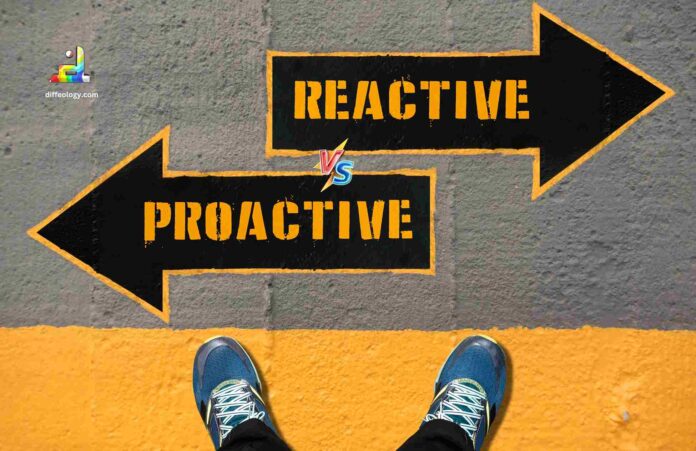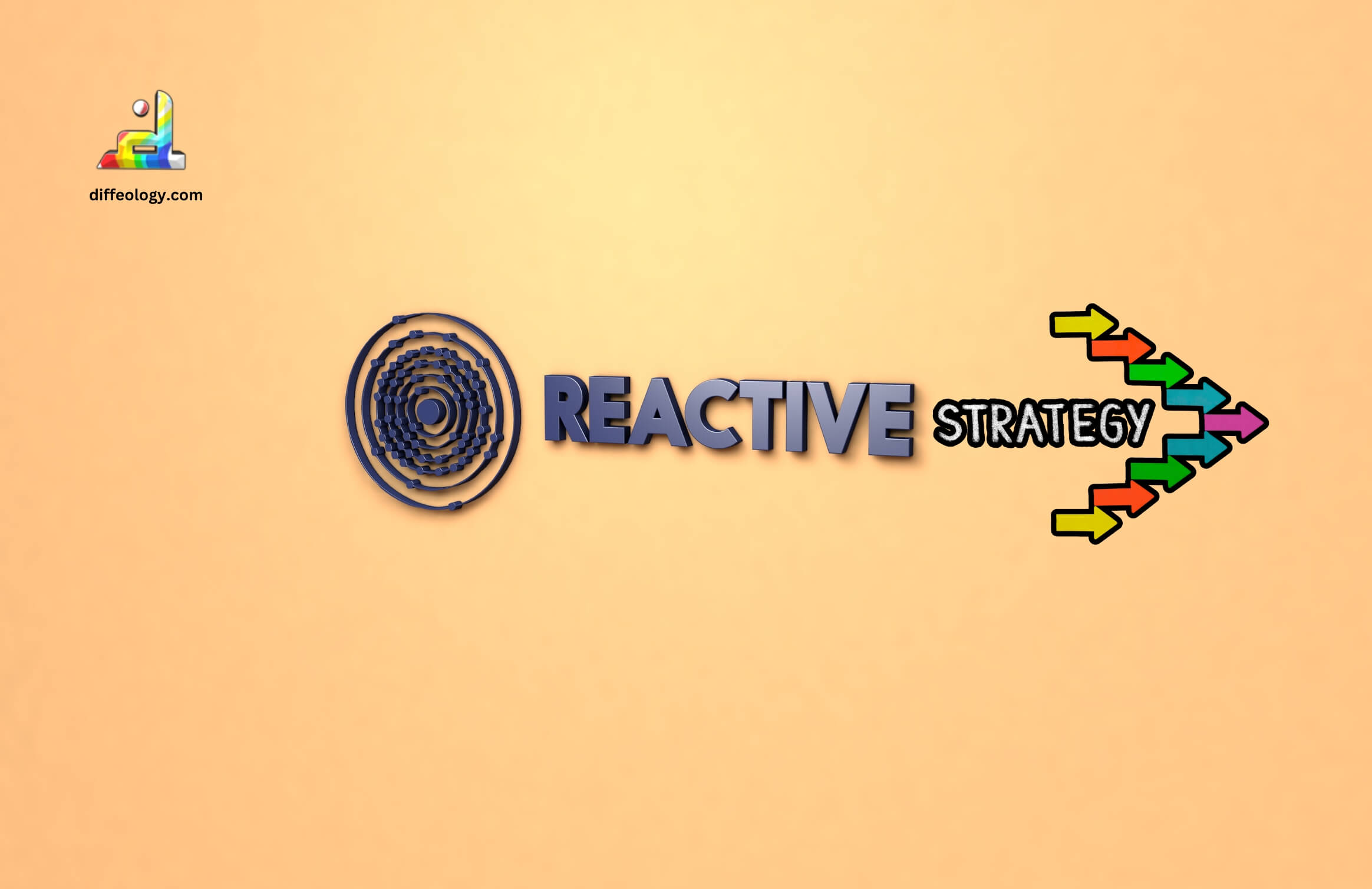In the world of decision-making and problem-solving, two key strategies stand out: proactive and reactive approaches. A proactive strategy involves planning ahead to prevent problems before they occur. Imagine preparing for a test by studying well in advance to avoid last-minute cramming. On the other hand, a reactive strategy involves responding to problems after they’ve already happened. For example, waiting until the last minute to study and then panicking when you realize there’s too much material to cover. Understanding the difference between these strategies can help individuals and businesses make better choices in managing challenges and achieving goals.
Main Difference Between Proactive and Reactive Strategies
Proactive strategies involve planning ahead and taking preventive measures to avoid problems before they happen. On the other hand, reactive strategies involve responding to issues after they have already occurred. Proactive approaches focus on foreseeing challenges and preparing solutions in advance, while reactive approaches deal with problems as they arise without prior planning. Being proactive requires a forward-thinking mindset that anticipates future needs, whereas reactive responses often result from immediate necessity or crisis.
Proactive Vs. Reactive Strategies
What are Proactive Strategies?
A proactive strategy is an approach aimed at anticipating and preventing problems before they occur. It involves planning, preparation, and taking preemptive action to minimize risks and maximize opportunities. For example, in business, companies use proactive strategies to forecast market trends and adapt their products or services accordingly. By analyzing past data and conducting market research, businesses can identify potential challenges early and develop strategies to address them proactively.
Read Also: Difference Between Omnivert and Ambivert
Proactive strategies offer several benefits, including cost savings, improved efficiency, and better risk management. For instance, in healthcare, preventive care programs are proactive strategies designed to promote wellness and reduce the incidence of chronic diseases. These programs educate patients about healthy lifestyles and encourage regular check-ups, aiming to prevent serious health issues before they require costly treatments.
Proactive strategies are also crucial in personal finance. Saving money regularly and investing wisely are proactive financial strategies that help individuals build wealth over time. By planning for the future and taking consistent action, individuals can achieve their financial goals and secure their financial well-being.
What are Reactive Strategies?
Reactive strategies are actions or responses taken in response to a problem or an event that has already occurred. These strategies are typically implemented after an issue arises without prior planning or anticipation. For example, in education, reactive strategies may involve disciplining a student for misbehavior after it has happened. In healthcare, reactive measures could include treating a patient for an illness after symptoms appear rather than focusing on preventive care.
Reactive strategies are characterized by their immediate nature and often lack the foresight and preparation seen in proactive approaches. They are designed to address the current situation but may not prevent similar issues from recurring in the future.
Read Also: Difference Between Elopements and Micro Weddings
Examples of reactive strategies can be found in various sectors. In business, responding to a sudden drop in sales by launching last-minute marketing campaigns is a reactive strategy. While this may mitigate immediate losses, it does not address underlying market trends that led to the decline. Similarly, in environmental management, reacting to a pollution incident by cleaning up the affected area is necessary but does not prevent environmental harm in the first place.
The impact of reactive strategies can vary. While they are essential for crisis management and immediate problem-solving, over-reliance on reactive approaches can hinder long-term planning and growth. Organizations and individuals benefit from balancing reactive responses with proactive strategies to achieve sustainable success and resilience in the face of challenges.
Comparison Table “Proactive Strategy Vs. Reactive Strategy”
| Focus | Anticipates and prevents problems before they occur | Reacts to problems after they occur |
| Approach | Takes initiative and plans ahead to minimize risks | Responds when issues arise without prior planning |
| Risk Management | Identifies and mitigates potential threats early | Addresses risks after they materialize |
| Decision Making | Takes proactive steps based on foresight and analysis | Makes decisions in response to current events or crises |
| Planning | Prepares strategies in advance to achieve goals | Often lacks a structured plan and reacts spontaneously |
| Resource Allocation | Allocates resources based on forecasts and potential needs | Utilizes resources reactively in response to immediate demands |
| Performance | Maintains consistent performance by preventing disruptions | Performance may fluctuate due to reactionary measures |
| Innovation | Encourages innovation by addressing issues before they escalate | Innovation may be stifled due to focusing on immediate problems |
| Leadership | Demonstrates strong leadership through foresight and planning | Leadership is tested in crisis management situations |
| Long-Term Impact | Tends to have a positive long-term impact by preventing recurring issues | May lead to repeated problems if underlying causes are not addressed |
Difference Between Proactive and Reactive Strategies in Detail
Definition
Proactive strategies involve taking the initiative to prevent potential issues before they occur. This approach focuses on planning and preparation, aiming to minimize risks and maximize opportunities. For example, a company that conducts regular maintenance on its equipment proactively reduces the likelihood of unexpected breakdowns, thus saving time and money.
Reactive strategies, on the other hand, respond to issues after they have already happened. This approach is often about quick fixes and damage control. For instance, a business that only fixes equipment when it breaks down reacts to problems as they arise, potentially facing downtime and higher repair costs.
Time Horizon
Proactive strategies typically have a longer time horizon as they involve foresight and planning. Organizations using proactive methods invest in continuous improvement and future-proofing their operations. In contrast, reactive strategies tend to be short-term solutions aimed at resolving immediate issues without necessarily addressing underlying causes.
Research shows that proactive management leads to greater efficiency and fewer crises over time, contributing to sustainable growth and stability.
Risk Management
Proactive approaches emphasize risk management by identifying potential hazards and taking preventive actions. This proactive risk management reduces the likelihood of emergencies and improves overall safety. Conversely, reactive approaches often lead to higher risk exposure due to their tendency to deal with risks only after they have materialized.
In educational settings, proactive strategies in classroom management create a conducive environment for learning by addressing potential disruptions before they escalate.
Cost Effectiveness
Proactive strategies are generally more cost-effective in the long run because they prevent costly issues from occurring. For example, regular health screenings can proactively detect health problems early, reducing treatment costs compared to reactive treatments for advanced illnesses.
In project management, proactive approaches reduce the likelihood of budget overruns and schedule delays by anticipating potential obstacles and planning accordingly.
Customer Satisfaction
Proactive customer service anticipates customer needs and addresses them before customers even realize there is a problem. This approach enhances customer satisfaction and loyalty. In contrast, reactive customer service only responds to complaints after they are voiced, which may lead to customer frustration and dissatisfaction.
Companies that implement proactive customer support see higher retention rates and better brand reputation.
Adaptability
Proactive strategies encourage adaptability by preparing organizations to respond effectively to changes and challenges. This adaptability is crucial in dynamic environments where unexpected events can occur. Reactive strategies, however, often result in scrambling to adjust to unforeseen circumstances without adequate preparation.
Educational institutions that adopt proactive measures in curriculum development and teaching methodologies stay ahead in adapting to new educational trends and needs.
Innovation
Proactive organizations tend to foster innovation by investing in research and development to stay ahead of competitors. This proactive innovation leads to the creation of new products and services that meet evolving customer demands. In contrast, reactive organizations may lag in innovation as they focus more on addressing immediate issues rather than exploring future opportunities.
Studies indicate that proactive innovation strategies contribute significantly to organizational growth and competitiveness.
Employee Engagement
Proactive management fosters higher levels of employee engagement by involving employees in decision-making processes and encouraging proactive contributions. This engagement improves morale and productivity as employees feel valued and motivated to contribute to organizational success. In contrast, reactive management may lead to disengagement as employees may feel sidelined until problems arise.
Organizations that prioritize proactive employee engagement strategies see reduced turnover rates and increased teamwork.
Leadership Effectiveness
Proactive leaders demonstrate foresight and strategic planning skills, inspiring confidence and trust among their teams. They are adept at steering their organizations toward long-term goals with resilience against potential setbacks. Reactive leaders, however, may struggle with crisis management and long-term planning, potentially compromising organizational stability.
Effective leadership through proactive strategies is crucial for navigating uncertainties and achieving sustainable growth.
Environmental Impact
Proactive environmental strategies focus on sustainability and conservation efforts to minimize ecological footprint and promote environmental stewardship. These strategies include waste reduction, energy efficiency, and eco-friendly practices. Reactive approaches in environmental management often result in environmental damage due to delayed responses to pollution or resource depletion.
Organizations that integrate proactive environmental policies enhance their reputation as responsible corporate citizens and contribute positively to environmental preservation.
Health and Safety
Proactive health and safety measures prioritize accident prevention through training, hazard identification, and the implementation of safety protocols. These measures reduce workplace injuries and illnesses. In contrast, reactive health and safety management addresses incidents after they occur, potentially leading to more severe consequences for employee well-being.
Industries that adopt proactive safety cultures see improved employee morale, reduced absenteeism, and lower insurance costs.
Quality Management
Proactive quality management focuses on preventing defects and ensuring consistent product or service quality through rigorous standards and continuous improvement processes. This approach enhances customer satisfaction and loyalty by delivering reliable products. Reactive quality management addresses quality issues as they arise, potentially leading to customer dissatisfaction and increased costs for rework.
Companies that implement proactive quality management systems achieve higher levels of operational efficiency and competitiveness.
Legal and Compliance
Proactive legal and compliance strategies involve staying ahead of regulatory requirements through diligent monitoring and proactive adjustments to policies and practices. This proactive approach reduces legal risks and potential penalties. In contrast, reactive legal strategies may result in legal disputes and financial liabilities due to non-compliance or oversight.
Organizations that prioritize proactive compliance measures demonstrate corporate responsibility and safeguard their reputation in the market.
Long-Term Sustainability
Proactive strategies contribute to long-term organizational sustainability by fostering resilience and adaptability in changing market conditions. By anticipating challenges and opportunities, proactive organizations position themselves for sustained growth and profitability. Reactive strategies, however, may result in short-term gains but can jeopardize long-term viability due to their inherent risk of overlooking future trends and threats.
Sustainable growth through proactive strategies is essential for businesses aiming to thrive in competitive markets and maintain stakeholder confidence.
Key Points Showing the Difference Between Proactive and Reactive Strategies
- Impact: Proactive strategies can lead to better outcomes and efficiency by preventing issues, whereas reactive methods may result in more time and resources being spent on resolving problems.
- Flexibility: Proactive approaches allow for more flexibility in handling situations due to preparedness, whereas reactive responses may be more rigid and limited by the nature of the problem.
- Prevention vs. Reaction: Proactive strategies aim to prevent issues altogether, while reactive strategies focus on reacting to problems after they have already affected the situation.
- Leadership: Proactive leaders are often seen as visionaries who plan for the future, whereas reactive leaders may excel in crisis management but can struggle with long-term planning.
- Risk Management: Proactive approaches help in identifying and mitigating risks early, while reactive strategies manage risks once they’ve already impacted operations.
- Innovation: Proactive strategies can foster innovation by allowing room for creative problem-solving before issues escalate, whereas reactive responses may stifle innovation due to their urgent nature.
- Long-term vs. Short-term: Proactive strategies are more geared towards long-term benefits and sustainability, while reactive strategies often focus on short-term fixes.
- Employee Engagement: Proactive management can enhance employee engagement by preventing burnout and addressing issues before they impact morale, whereas reactive management may lead to stress and dissatisfaction among employees.
- Cost Efficiency: Proactive strategies can save costs in the long run by reducing the need for emergency expenditures, while reactive strategies may incur higher costs due to unexpected crises.
- Learning and Improvement: Proactive approaches encourage continuous learning and improvement through foresight and analysis of potential challenges, whereas reactive responses may miss opportunities for growth and development.
- Adaptability: Proactive strategies promote adaptability by preparing for various scenarios, while reactive strategies can struggle with adapting to unforeseen circumstances due to their unplanned nature.
FAQs: Proactive Vs. Reactive Strategies
Conclusion:
After knowing the Difference Between Proactive and Reactive Strategies, picking the one is your choice. Choosing between proactive and reactive strategies often determines success in various aspects of life, from school and work to personal relationships. By adopting a proactive approach, individuals can minimize risks, maintain consistency, and foster innovation by addressing issues before they escalate. In contrast, relying solely on reactive responses may lead to increased stress, inconsistent performance, and missed opportunities for improvement. Learning to anticipate and prepare for challenges ahead of time empowers individuals to take control of their outcomes and build a foundation for long-term success.
References & External Links
- Proactive market strategies and digitalisation
- The Basics of Reactive Marketing Strategy



